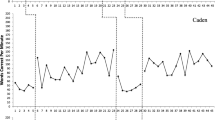Abstract
Reading is a fundamental skill for success in school and as an adult. However, many children and adults experience difficulties reading. Previous research has demonstrated that repeated readings is an effective intervention for increasing both fluency and comprehension for elementary age readers of all skill levels. However, the impact of repeated readings on fluency and comprehension has not been examined with secondary students with reading deficits. The purpose of this study was to examine the effectiveness of repeated readings for increasing four secondary student's fluency on passages at their instructional level, at the ninth grade level, and on generalization passages from their school curriculum. Furthermore, the effects on comprehension were also explored. A comparison group of average readers served as an estimate for how fluently secondary students read. The results of this study demonstrated that fluency improvements were achieved for all of the participants with just ten additional hours of practice. Effects on comprehension were not as clear. Limitations and future directions for research are discussed.
Similar content being viewed by others
References
Baydar, N., Brooks-Gunn, J., & Furstenberg, F.F. (1993). Early warning signs of functional illiteracy: Predictors in childhood and adolescence. Child Development, 64, 815-829.
Center for Education Reform. (1998). A nation still at risk: An education manifesto. Retrieved October 12, 1999, //edreform.com/pubs/manifest.htm.
Chall, J. S. (1983). Stages of reading development. New York: McGraw-Hill.
DeBettencourt, L. U., Zigmond, N., & Thornton, H. (1989). Follow-up postsecondary-age rural learning disabled graduates and dropouts. Exceptional Children, 56, 40-49.
Deno, S. L., Fuchs, L. S., Maston, D., & Shin, J. (2001). Using curriculum-based measurement to establish growth standards for students with learning disabilities. School Psychology Review, 30, 507-524.
Dowhower, S. L. (1987). Effects of repeated reading on second-grade transitional readers' fluency and comprehension. Reading Research Quarterly, 22, 389-406.
Espin, C. A., & Tindal, G. (1998). Curriculum-based measurement for secondary students. In M. R. Shinn (Ed.), Advanced applications of Curriculum-Based Measurement (pp. 214-253). New York, NY: The Guilford Press.
Francis, D. J., Shaywitz, S. E., Stuebing, K. K., Shaywitz, B. A., & Fletcher, J. M. (1996). Developmental lag versus deficit models of reading disability: A longitudinal, individual growth curves analysis. Journal of Educational Psychology, 88, 3-17.
Fuchs, L. S., Fuchs, D., & Maxwell, L. (1988). The validity of informal reading comprehension measures. Remedial and Special Education, 9, 20-28.
Gillespie, C., & Rasinski, T. (1989). Content area teachers' attitudes and practices towards reading in the content areas. Reading Research and Instruction, 28, 45-67.
Herman, P. A. (1985). The effect of repeated readings on reading rate, speech pauses, and word recognition. Reading Research Quarterly, 20, 553-565.
Hintze, J. M., Daly, E. J., & Shapiro, E. S. (1998). An investigation of the effects of passage difficulty level on outcomes of oral reading fluency progress monitoring. School Psychology Review, 27, 433-445.
Homan, S. P., Klesius, J. P., & Hite, C. (1993). Effects of repeated readings and nonrepetitive strategies on students' fluency and comprehension. Journal of Educational Research, 87, 94-99.
Levin, E. K., Zigmond, N., & Birch, J. W. (1985). A follow-up study of 52 learning disabled adolescents. Journal of Learning Disabilities, 18, 2-7.
National Reading Panel. (2000). Summary report. Retrieved 7/22/02 from www.nationalreadingpanel.org/Publications/piublications.htm.
Rashotte, C. A., & Torgesen, J. K. (1985). Repeated reading and reading fluency in learning disabled children. Reading Research Quarterly, 20, 180-188.
Rasinski, T. V. (1990). Effects of repeated reading and listening-while-reading on reading fluency. Journal of Educational Research, 83, 147-150.
Samuels, S. J. (1979). The method of repeated readings. Reading Teacher, 32, 403-408.
Shinn, M. R. (1989). Curriculum-Based Measurement: Assessing special children. New York, NY: The Guilford Press.
Sindelar, P. T., Monda, L. E., & O'Shea, L. J. (1990). Effects of repeated readings on instructional-and mastery-level readers. Journal of Educational Research, 83, 220-226.
Skinner, C. H., & Shapiro, E. S. (1989). A comparison of taped-words and drill interventions on reading fluency in adolescents with behavior disorders. Education and Treatment of Children, 12, 123-133.
Slocum, T. A., Street, E. M., & Gilberts, G. (1995). A review of research and theory on the relation between oral reading rate and reading comprehension. Journal of Behavioral Education, 5, 377-398.
Spargo, E. (1989). Timed Readings, third edition. Lincolnwood, IL: Jamestown Publishers.
Stanovich, K. E. (1986). Matthew effects in reading: Some consequences of individual differences in the acquisition of literacy. Reading Research Quarterly, 21, 360-406.
Stoddard, K., Valcante, G., Sindelar, P., O'Shea, L., & Algozzine, B. (1993). Increasing reading rate and comprehension: The effects of repeated readings, sentence segmentation, and intonation training. Reading Research and Instruction, 32, 53-65.
Weinstein, G., & Cooke, N. L. (1992). The effects of two repeated reading interventions on generalization of fluency. Learning Disability Quarterly, 15, 21-28.
Woodcock, R. W. (1987). Woodcock Reading Mastery Tests-Revised. Circles Pines, MN: American Guidance Service.
Young, A. R., Bowers, P. G., & MacKinnon, G. E. (1996). Effects of prosodic modeling and repeated reading on poor readers' fluency and comprehension. Applied Psycholinguistics, 17, 59-84.
Author information
Authors and Affiliations
Corresponding author
Rights and permissions
About this article
Cite this article
Valleley, R.J., Shriver, M.D. An Examination of the Effects of Repeated Readings with Secondary Students. Journal of Behavioral Education 12, 55–76 (2003). https://doi.org/10.1023/A:1022322422324
Issue Date:
DOI: https://doi.org/10.1023/A:1022322422324




